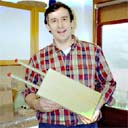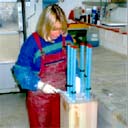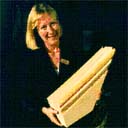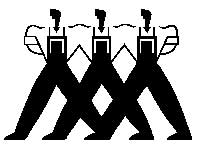Property Repair Systems Group - specialists in Woodworm Treatment Products
NOTE - 'Borax' was a Company Name (now called 'Rio Tinto Borax') and does not, on its own, describe a particular product. Some Suppliers are offering cheap, so called 'Borax' for Woodworm Treatment - this is not the correct chemical and is not licensed for Woodworm Treatment. If you are offered a Chemical with a name ending in 'decahydrate' (rather than 'tetrahydrate) you are being sold an old component of Borax Soaps, not an insecticide, (Polybor or Timbor).
Brief History of Boron
Compounds of Boron, known as Borates, have been mined since the 1800s and have been used to control insect pests for over 100 years.
Boron was discovered in the USA in the late 1800's and first mined by Francis M 'Borax' Smith in 1872 as the crystalline material 'tincal', which contains about 50% borate.
Purified and sold throughout the world in vast quantities as Tim-bor Professional, it poses a low risk to the environment, especially when compared with other current pesticides, particularly because of its lower toxicity to fish. Now backed by more than 100 years of research and development, it is manufactured in the USA by Rio Tinto Borax, based in Valencia, California.
By the 1940s Borate formulations were being used to protect wood. Because they are water soluble, Borates diffuse into wood using the wood's own moisture (even 'air dry' timber has a moisture content of 12-15%) and they protect against woodworm, Death Watch beetle, House Longhorn beetle, Termites, Carpenter ants and fungi, including Dry rot.
For well over 60 years Borates have been in successful use in Europe, Australia, New Zealand and the USA. Borates are used in dusting, foaming, spraying, brushing and pressure treatment applications. Other major uses include: glass production, detergent preparations, enamel and ceramic glazes.
Brief History of Property Repair Systems
David Moore started the Company in 1997 having spent over 20 years in the Damp Proofing and Timber Preserving Industry, both as a Contractor and as Sales Development Manager for a National Chemical Formulator. Woodworm Dry Rot and Dampness in buildings are his main concerns.

David gives birth to the first production Timber-Resin Splice (its a boy).
He decided to form the business after having been made redundant and after an abortive attempt to sell 'solid' Resin Repairs to an unreceptive public. The high cost of epoxy Resin effectively reduces the number of such 'solid' repairs to a handful each year (not enough to live on as a commission only Sales Agent) and the appearance of the final job usually dissuades the majority of Clients and Heritage bodies from using this excellent, but expensive technique.
Whilst sitting in a Welsh pub contemplating this phenomenon David suddenly had a Eureka moment - why not replace most of the resin with wood - and thus, over a pint, the 'Timber-Resin Splice ' was born. The new concept - pre-manufacture a new piece of wood to exactly replace the missing part, fitted with bars or slots ready for connection and supply the whole thing as a 'kit'. Now any Contractor can repair any beam or joists in timber to exceed the original strength, and offer a truly neat, cosmetic finish.
The business today manufactures all the 'Timber-Resin Splice' kits for the UK, some several thousand being produced per annum. The product holds a current UK Patent.
To complement this manufacturing activity David had a special range of Boron-based preservative produced to his specification, drawing on many years of successfully marketing Boracols and other Borate-Glycols.
Resins to repair splits and shakes in timber, cracks and voids in masonry and to treat external masonry and timber naturally followed.
A complete Design service was also developed, using fast, Computer-based packages, which gives the Clients instant access to Structural Engineering Calculations, Designs and Method Statements. Estimates are instant - we'll even give you guidance on the number of man-hours required to install the 'TRS Kit'.

Kathy installing bars in a TRS
David is supported by his wife, and business Partner, Kathy, together with Angela, his sales colleague of some 20 years, who brings a wealth of knowledge and experience to sales, manufacturing and customer service.
No beam repair is too large or too small for this team.

Kathy holding part of a multi-part arch
REFERENCE SOURCES
A few examples of English titled papers and summary titles - ask for a full list
Cummins 1939 - Powder post borer
Drysdale 1994 - Fungi and termites
Lloyd 1991 - Treatment of pine
Lloyd 1997 - International status of borate
Spiller 1948 - Toxicity to anobium
Taylor 1967 - Toxicity to CFB & Longhorn
Suomi & Akre 1992 - Control of Beetles
Graf 1998 - Treatment of spruce
Berry 1991/2 - BRE Tests C51 - Serpula
BBA Certificate - Wykamol No.93/2893
European Directive 98/8/EC - Technical Committee of the Netherlands.
Woodworm Treatment | Death Watch Beetle Treatment | House Longhorn Beetle Treatment
Woodworm Sprayers and Accessories | FAQs | Boron Treatment Range | Shop
References | Privacy Policy | Returns Policy | Technical & Safety | Contact | Links | Testimonials

Property Repair Systems
T: 01626 872886
E: help@propertyrepairsystems.co.uk
Site written by: David Moore
David Moore, B.A. (Hons.), C.T.I.S., C.R.D.S. Technical Author
Google+